Top News

March 12, 2012 Yoko Oshiro correspondent of the Ryukyu Shimpo
Artist Akiyoshi Ito, who is famous for his underwater photography, is holding an exhibition in the Tropical Aquarium Porte Doree in Paris from February 2 to March 15. This is the second such exhibition to be held overseas, following that held in the Smithsonian Museum in 2005. It was made possible thanks to support from the director of the aquarium, Michel Hignette. Former Minister of Culture Jacques Toubon who attended the reception took his time to enjoy each of the works, and asked Ito many detailed questions.
About 80% of the works are underwater photographs of the sea around Okinawa and some depict scenes that no longer exist because of the effects of coral bleaching.
His stereoscopic and brilliantly colored works attracted the attention of many people. The visitors to the exhibition were fascinated when they heard that the pictures’ strong colors are not retouched, but represent the original color of the creatures when exposed to light.
Ito commented, “It is important to show the quality of the underwater world in the most beautiful way possible. I believe that if people could make contact with nature through my work they will be able to enhance their awareness of nature. I think that this is the mission of an artist.”
The next exhibition is scheduled to be held on the Arinari National Museum of Photography in Italy in September.
(English translation by T&CT, Shinako Oyakawa and Mark Ealey)
Go To Japanese
March 14, 2012 Ryukyu Shimpo
On March 13, Ginowan Municipal Office representatives met with the city’s five key entities to discuss the issue of the deployment of the MV-22 Osprey vertical take-off and landing transport aircraft to the U.S. Marine Corps Air Station Futenma and confirmed plans to hold a protest rally against the deployment in mid to late June after the prefectural assembly election.
The tentative theme of the rally is “Ginowan citizens’ rally against the deployment of the Osprey aircraft to Futenma Air Station and for the early return of Futenma Air Station.” Six major groups from the city including the Ginowan Municipal Office, City Council, Community Leaders Association, Senior Club Association, Women’s Association, and Youth Association will organize the planning and preparatory committee. At a preparatory meeting on April 6, the committee will decide upon a date and a location in the vicinity of Ginowan Seaside Park.
After the meeting, Mayor Atsushi Sakima said, “Both the City and Prefectural Councils have adopted a resolution to oppose the deployment. As a mayor voted in to represent citizens, I oppose any deployment that poses problems for citizens’ security and lives. I would like to bolster efforts to prepare for and inform people about the rally.”
It has been eight years since the city held its last protest against the U.S. military helicopter crash in September 2004. Carrying out a sit-in protest last year, the six major groups from Ginowan have already protested against the deployment of the Osprey aircraft.
(English translation by T&CT, Megumi Chibana and Mark Ealey)
Go To Japanese
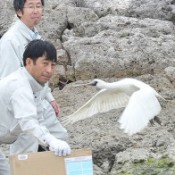
March 15, 2012 Ryukyu Shimpo
On March 14, a black-faced spoonbill that had been entangled in fishing line recovered from its troubled situation flew into the sky over the Toyosaki mudflats, Tomigusuku. Two staff members of the Nature Conservation Section of the Okinawa Prefectural Government (OPG) released the rare migratory bird from a cardboard box and noted that it flew away and landed on the flood-control basin at Yone a few kilometers far away, where it bathed with eight other spoonbills.
On March 11, the spoonbill found itself under the protective wing of the OPG, and received treatment in a veterinary hospital in Naha. Before it was released back to the wild, the bird recovered enough to eat 100 smelts a day.
Masakuni Yamashiro, the chairman of the Wild Bird Society of Okinawa said, “I want people who go fishing to cooperate by not leaving fishing lines around. We are going to put up warning posters about this.”
(English translation by T&CT, Mark Ealey)
Go To Japanese

Go To Video
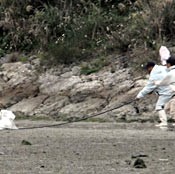
March 12, 2012 Ryukyu Shimpo
On the evening of March 11, a black-faced spoonbill that had been found with a fishing line wrapped around its beak on March 4 at the mud flats in the southern part of the main island, was taken into care.
From around 4:30pm that day, more than a dozen people including members of the Natural Environment Office of the Ministry of the Environment in Naha, the Nature Conservation Section of the Okinawa Prefectural Government and the Wild Bird Society of Okinawa observed the spoonbill. After about an hour, the bird became unable to fly and the people who noticed it captured it using a net. The spoonbill is now receiving medical treatment at a veterinary hospital in Naha.
(English translation by T&CT, Lima Tokumori and Mark Ealey)
Go To Japanese

March 9, 2012 Ryukyu Shimpo
Shipments of chrysanthemums went from Okinawa for Higan, the Buddhist equinoctial week. On March 8, on a special All Nippon Airways flight to Haneda Airport, the Okinawa Flower Agricultural Cooperative shipped chrysanthemums for use all over Japan.
Last year, the level of demand was down because of the Great East Japan Earthquake, and growers had to dispose of around one-tenth of the chrysanthemums grown, so shipments for this period exceed those of the previous year. However, compared to the same period in 2010, they are down 1.4%, but are around the same as in usual years. This present period marks the one-year anniversary of the Great East Japan Earthquake, and the number of advance orders is increasing.
On March 8, at the cargo terminal in Naha Airport, a departure ceremony of the first shipment was held. Manabu Kaneshima, a representative of the cooperatives, said, “Last year was a very difficult year, but this year we have been able to ship the same quantity of flowers as a normal year.” He praised the farmer’s hard work, and went on to say, “Prices are firm. Also, March 17, the day that the Higan equinoctial week starts, coincides with a long weekend. High prices are likely, so I hope that we can make up for the losses of the previous year.”
By March 15, the cooperatives plans to make more three shipments and expect to ship over 248000 boxes, with 200 chrysanthemums in each box, which is a 10% increase over the previous year. There was less sunlight than usual this January, but the weather improved from February, so the quality of the chrysanthemums also improved. The items shipped include large and small chrysanthemums, spray mums and dracaena.
(English translation by T&CT, Lima Tokumori and Mark Ealey)
Go To Japanese

March 13, 2012 Ryukyu Shimpo
In Ishigaki, people saw the first baby water buffalo in many a year, and have named it Katsuzakura. Yoji Fukunaka, a teacher at Yaeyama Agriculture High School and Karin Heanza, a second grade student, have been taking care of the buffalos. Katsuzakura is the first baby water buffalo to be born in Ishigaki in the Heisei period, which started in 1989. On February 4, Katsuzakura was born between his father Katsujiro from Taketomi-jima and mother Sakura from Yufu-jima. Fukunaka and a vet pulled him out of his mother’s body after a struggle that lasted for an hour, because it was a difficult birth as they only saw one leg appear.
He weighed about 30 kilograms at birth, but has grown to 65 kilograms in the month since then. The naughty baby water buffalo now runs happily around his mother. Before Okinawa’s reversion to Japanese sovereignty, people kept water buffalos for farming in Ishigaki. They were useful for cultivating the fields because they were comfortable working in mud in the rice paddies where horses will not go. After Okinawa returned to Japan, farmers started to use machines for farming and the number of buffalo owners gradually decreased. A small number of water buffalos currently work in Taketomi and Yufu-jima pulling carts for tourists.
Fukunaka, who keeps four of the five water buffalos on Ishigaki, was delighted to see a baby buffalo after such a long time. He said, “I want to recreate the kind of scene that was common before Ishigaki reverted to Japanese sovereignty in which many buffalos worked in the fields.” Heanzan said, “Katsuzakura is really cute.” She enjoys helping to feed and give water to the baby buffalo.
(English translation by T&CT, Mark Ealey)
Go To Japanese
March 13, 2012 Ryukyu Shimpo
With regard to the omoiyari yosan, the financial burden that Japan pays towards the cost of U.S. forces stationed on its territory, for the 33 years from fiscal 1979 to 2011, the number of cases in which the Ministry of Defense carried out maintenance and repair works for U.S. military facilities in Okinawa amounted to 4020, and the cost reached 555.643 billion yen. These numbers were revealed in documents that Ryukyu Shimpo acquired from the ministry on March 12.
The number of cases involving the maintenance and repair works for military family housing amounted to 3465, accounting for about 90% of the total and the costs reached 132.652 billion yen.
The total floor area for each military dwelling is about 150 square meters, about twice the total area for a detached house in Okinawa, which is 75.9 square meters on average (from statistics provided by the Ministry of Internal Affairs and Communications in 2008).
The Ministry of Defense implemented maintenance and repair work for 24 U.S. military facilities in Okinawa, including Kadena Air Base, Camp Kinser and Futenma Air Station. The ministry carried out maintenance and repair works for a wide variety of facilities, including those related to military operation support such as parking areas, hangars and the others related to daily life such as hospitals, schools and banks.
According to the ministry, there are two types of military family housing for which maintenance and repair work are carried out. Those with a total area of about 145 square meters have three bedrooms and the others with a total housing area of about 157 square meters, which have four bedrooms. Although the construction cost for each dwelling has not been revealed, excluding the cost of the land, the total cost of constructing the housing is estimated to be 45 to 50 million yen.
A representative of the Facilities Improvement Program Division of the ministry said, “We have decided the area and scale for U.S. military facilities in Okinawa on which maintenance and repair works are carried out, in keeping with the standard set by the United States to make the Japan-U.S. alliance effective. Although we have been carrying out the necessary work to maintain the alliance, we have also been striving to reduce expenses. We would like to utilize technologies such as photovoltaic power generation to make savings.”
(English translation by T&CT, Mark Ealey)
Go To Japanese
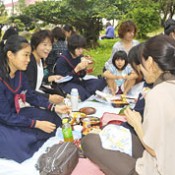
March 8, 2012 Ryukyu Shimpo
On March 7, on Miyako Island, an entrance examination for prefectural high schools was held. As has become an annual tradition, this year students and their family members gathered to eat lunch together. In the past, when there were very few restaurants near schools in Miyako, some families started to bring their lunch boxes for students who had come from other small islands and couldn’t have lunch at home. Since then it has become an annual event at the time of the entrance examination for high schools.
At Miyako High School, where about 200 students took the examination, many people brought lunch boxes to the schoolyard, gymnasium and classrooms. Naomi Shimoji took a day off work to make lunch with her daughter for her son Takumi of Karimata Junior High School. She said, “I chose foods that might bring good luck for passing the exam.” Ikuyo Kato, whose daughter sat the examination, said, “To be careful not to upset her stomach, I didn’t use any perishables other than fruit.”
(English translation by T&CT, Lima Tokumori and Mark Ealey)
Go To Japanese
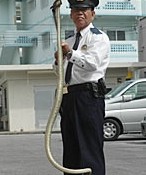
March 8, 2012 Ryukyu Shimpo
At around 10:00pm on March 5, Kouki Tarama, a police officer of the Yagaji Police Substation in Nago caught a poisonous habu snake that was about 1.5 meters in length in the front yard of the police substation. Nago Police Station drew residents’ attention to the habu, saying that the snakes are active earlier than in a normal year.
A officer of the Yagaji Police Substation found a habu moving near the doorstep of the office and tried to catch it using a snake capture stick. The snake resisted by putting its head in among the flowers in the flower bed, but he eventually caught it.
According to the Nago Police Station, since the beginning of March, the police have received reports about snakes from residents on a daily basis. Seikei Yamane, deputy chief of the Nago Police Station, said, “The number of reports about habu normally increases in May, but this year, because of warmer weather than usual, we have received many reports in March. Residents should be very careful about snakes.”
(English translation by T&CT, Mark Ealey)
Go To Japanese
March 8 2012, Ryukyu Shimpo
The return and relocation of U.S. Marine Corps Air Station Futenma was agreed upon by the United States and Japan in the Special Action Committee on Okinawa (SACO) in December 1996. It has been revealed that in the years since the agreement, from its defense budget, the Japanese government has paid about 1.6 billion yen for maintenance and repair work for Futenma Air Station as part of the omoiyari yosan (the so-called “sympathy budget”), the financial burden Japan pays for the cost of U.S. forces stationed in Japan. Parliamentary Vice-Minister of Defense Mitsu Shimojo explained this at the Special Committee on Okinawa and Northern Problems held on March 7.
With regard to renovating the base, the Japanese and the U.S. governments have been discussing the need for a large-scale upgrade, and it is possible that the Japanese side could shoulder the expense.
The Japanese government has paid a total of 1.5 billion yen towards the cost of upgrading the base. The specifics are 450 million yen towards the cost of the renovation of air-conditioning facilities in barracks during the period from 1998 to 1999, 930 million yen towards the cost of the maintenance of two primary storehouses during the period from 1998 to 2000, and 180 million yen towards the cost of maintenance of runway threshold identification lights for security measures in the wake of the U.S. military helicopter crash into Okinawa International University. These funds come from the omoiyari yosan.
At the same time, the head of North American Affairs Bureau of the Ministry of Foreign Affairs, Junichi Ihara, explained that the U.S. government funded the cost for renovation works for the base’s runway, such as repainting pilot wires in 2005 and 2010.
With regard to the maintenance work on Futenma Air Station, Foreign Minister Koichiro Genba stated, “Necessary work needs to be carried out.” Genba said that the Japanese and the U.S. governments would determine which side should bear the costs for the work on the base on a case-by-case basis. In response to Seiken Akamine of the Japanese Communist Party, parliamentary vice-minister of Defense, Mitsu Shimojo, explained that the Japanese government had been carefully budgeting for the cost of the maintenance work on the base to avoid the situation that it, and its inherent risks, would become a permanent fixture.
(English translation by T&CT, Mark Ealey)
Go To Japanese
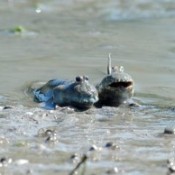
March 7, 2012 Ryukyu Shimpo
On March 7 courtship displays by rare bearded mudskippers (tokagehaze or Scartelaos histophorus) were seen on the tidal flats in Fusozaki, Nanjo. Because the temperature was relatively high, the mudskippers stand up to attract each other before cuddling up with their partners. The timing is early this year, with this behavior normally witnessed around the end of March into April.
The bearded mudskipper or tokagehaze in Japanese is an endangered species listed in the Red Book of the Ministry of the Environment. It is unique to Okinawa, where Fusozaki and Nakagusuku Bay provide the largest area of habitat. It is 15 centimeters long and has a mast-like long dorsal fin.
A high-pressure system moving up from the south pushed the temperature high on March 6. A record high of 28.4 degrees celsius was recorded on Hateruma Island.
(English translation by T&CT, Shinako Oyakawa and Mark Ealey)
Go To Japanese

Go To Video










 Webcam(Kokusai Street)
Webcam(Kokusai Street)


